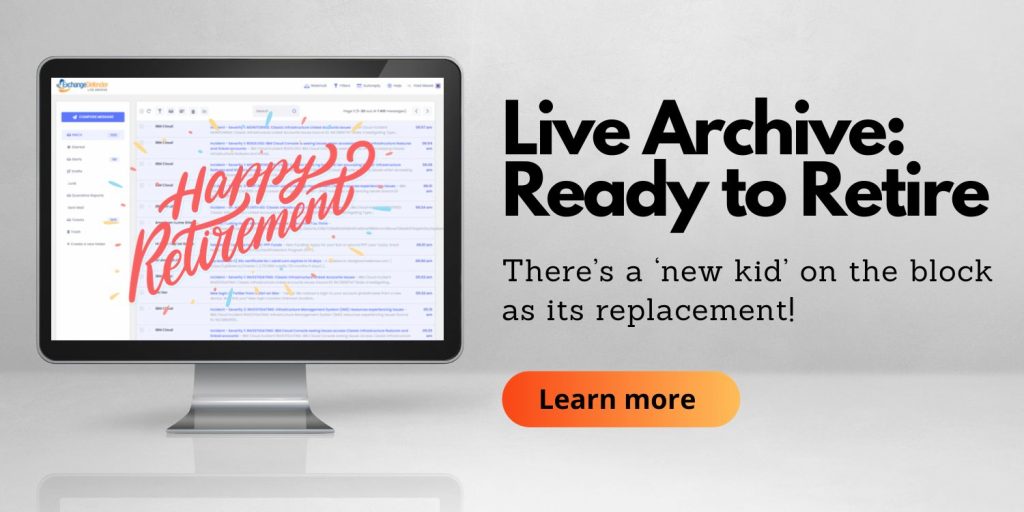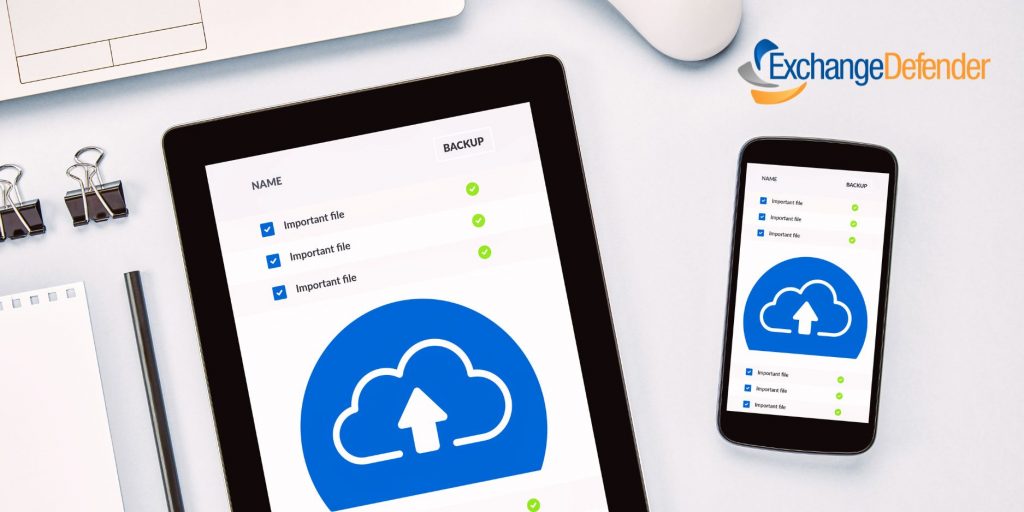Preparing for LiveArchive Retirement

As mentioned on our recent webinars and blog posts, LiveArchive has worked very hard for us for decades and it’s time for it to go to Florida and retire.
The new kid on the block – ExchangeDefender Inbox – has been running our client’s business continuity for over a year and it’s proven to be more efficient and popular than LiveArchive. Just log in to your account (https://admin.exchangedefender.com) or use passwordless login and click on Inbox. You’ll have the last two weeks of email waiting for you there and you can send/receive while your email server/mailbox/or whatever is down or under maintenance.
Longer Term Archiving
While Inbox will take care of our clients’ email needs when their email is having issues, many of you need long-term archiving. If LiveArchive was ever power-used it would be in the realm of data recovery after a disaster, cryptolocker, or other threat destroyed the client’s email infrastructure. For those of you who are aware of the risk, there will be a need for archiving to go way beyond two weeks – even years. This is what the new LiveArchive will start doing for you on January 1st, 2024!
First, let’s get ready for the retirement of the current LiveArchive – the service will shut off on December 31st, 2023 at which point all data including backups and configurations will be removed from our network. This means that if you wish to keep current LiveArchive contents the migration request must be put in as a ticket at our support site at https://support.exchangedefender.com. Simply open a ticket with the subject “LiveArchive Migration” and provide the domain names you wish to migrate and the S3/RDS login credentials by December 1st, 2023. As promised on the webinar, we are offering this migration free of charge to our clients and partners but you need to get in the line by December 1st and have your AWS S3/RDS or self-hosted setup completed.
Second, if you need any help with AWS S3/RDS or if you’d like assistance with deploying this solution in your home office or data center, we got you too. If you need help and get in touch with us by December 1st, we’ll take care of it for you. It’s super simple, takes about 5 minutes total, and is extensively documented – but we love our clients and if you want an extra pair of hands we can help you. After December 1st (and depending on availability) we will take care of the setup for a one-time fee of $499 for AWS or $999 for self-hosted.
Future of LiveArchive
We look forward to this middle tier that every organization that relies on email to run their business needs. For business continuity, Inbox will give you access to email anywhere, anytime. For backups and long-term retention across various clouds and storage options, LiveArchive will take care of archiving your data. For additional assurance and best-in-class storage that meets complex compliance and insurance requirements, ComplianceArchive is your eDiscovery and compliance archiving solution. Simply put no matter how critical email is to your organization we’ve got a solution that fits your problems and your budget.
The new LiveArchive will start doing for you on January 1st, 2024!
Announcing LiveArchive.Next

We’re excited to introduce you to our next version of LiveArchive: a long-term email archiving and backup solution that you can take with you. With the new LiveArchive we had to solve some unique challenges our clients face in 2023 and beyond:
1. We don’t have any room in our IT budget (and need to save $)
2. If we get compromised our backups will get crypto locked too
3. We have to protect and backup our email for years
We heard you loud and clear and the LiveArchive.next was designed from the ground up to give you the peace of mind that you’ll have access to your critical data even if Microsoft wipes your account, even if you get crypto locked out of your network, even if we go out of business, and yes it can also do it for you nearly free of charge.
Choice of Storage
LiveArchive.next uses object-based storage backend that is widely used and available for free with full source code. You don’t have to worry about the product getting discontinued or the company going out of business and most modern IT workers will have experience/certification for it. ExchangeDefender provides documentation on how to set a service up with Amazon Web Services using the S3 object storage if you want to keep your backups in the cloud. We also provide docker documentation for those who want to keep the backups on their own Synology NAS or as affordable as a Raspberry Pi.
There is no “one size fits all” when it comes to how you protect your backups and the point is to have flexibility that will fit your needs. LiveArchive.next will accommodate you no matter where you point it. Some organizations may rely on LiveArchive in the cloud to reduce complexity while others will point LiveArchive to their office NAS where they can save years of mailboxes and terabytes of data on an appliance/drives that can be taken offsite like old-timey tape backups you heard about in in IT history class.
Choice of Database Options
LiveArchive.next can optionally store your message metadata in an SQL database. While this is an optional part that isn’t required for backups to work, it does make LiveArchive very user-friendly. Without the database, all your messages will still be backed up and you will still be able to retrieve them directly from the S3 object storage bucket through a friendly web user interface or S3 client.
With Amazon RDS or MySQL configured, ExchangeDefender will also send message metadata to your database: sender email address, recipient email address, subject, date, etc. This information is used by our LiveArchive Web UI service to show users the friendly webmail interface you’ve become accustomed to.
This feature is optional but highly recommended by ExchangeDefender and you’ll appreciate it immensely the first time you’re sent on a quest to retrieve an email from 4 years ago.
Choose to be Live
Most backups are still performed as a scheduled task / job and only run periodically. When there is an issue the alert may or may not be sent to your IT staff and responsible IT providers have staff that frequently manually checks and verifies backups.
ExchangeDefender LiveArchive is live, meaning that a message that was received in your Outlook will be received in your LiveArchive archive in seconds instead of hours or days. There are no jobs or backup tasks to monitor or review – and we’ll notify you the second we identify a problem.
When you enable database services your users will be able to access their LiveArchive in realtime as well, so for those of you trying to save $ on IT this will help you to diversify some of the monitoring and risk away.
Additionally, everything being live means that our service will backup and archive email the moment it arrives so there is no job to set up, no new mailboxes or services to enroll. If the mail is hitting a mailbox in your organization you can expect it to automatically show up in LiveArchive in seconds.
To find out more about the next LiveArchive please join us for an informative webinar on November 8th, 2023. Take the moment to sign up for the ExchangeDefender LiveArchive Migration Service if you’d like us to port your existing LiveArchive data to your next LiveArchive. Check out all the documentation we’re putting out there and get in touch with us early because this service is in heavy demand and December quickly books up with EOY projects.
We look forward to helping you expand and improve your email protection in 2024 and beyond!
